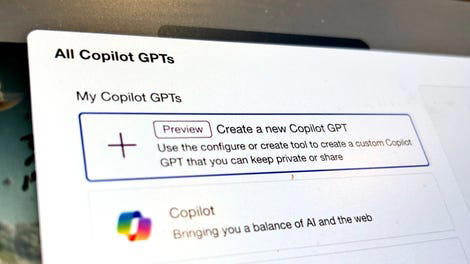
In the age of AI chatbots, numerous off-the-shelf options are available in the market, each offering a diverse array of functions. However, for tasks not covered by existing chatbots, the solution lies in creating your very own chatbot using Copilot Pro.
Recently unveiled in a preview release for Copilot Pro users, Microsoft discreetly introduced the “Custom Copilot GPTs” feature. This functionality empowers Pro users to fashion a personalized Copilot GPT complete with specific instructions, which can be kept private or shared for utilization by both free and paying Copilot users.
Initiating the process is straightforward. Navigate to your Copilot Pro homepage and select the “See all Copilot GPTs” option on the right side of the page, situated among Microsoft’s custom Copilots.
At the top of the list is the option to “Create a new Copilot GPT,” marked with a preview designation that guides users to “Use the configure or create tool to create a custom Copilot GPT that you can keep private or share.”
Subsequent steps for crafting the chatbot closely resemble those for generating a custom chatbot on ChatGPT, a process that demands no coding or technical expertise. It’s worth noting that ChatGPT’s comparable feature is exclusively available to ChatGPT Plus subscribers.
For those unfamiliar with creating a custom GPT, Microsoft provides a comprehensive list of tips for developing a high-quality Copilot GPT. These tips include advice such as keeping the name short and catchy, using clear language, ensuring prompts are specific and actionable, and more. The builder aids in the intuitive creation process by posing follow-up questions as you proceed.
A crucial initial step involves naming the chatbot and defining its purpose. For example, in this instance, the article outlines the creation of a chatbot named “Shakespeare tone,” designed to transform all user input text into the tone of a Shakespearean play.
The builder comprehends the task promptly and continues with follow-up questions about the chatbot’s behaviour, including an emphasis on specific topics or avoidance of others. Microsoft even offers sample prompts to facilitate the creation process.
Upon completing the basic follow-up questions, the builder notifies the user that the chatbot is ready, allowing them to preview it by clicking the “Preview Copilot GPT” button. Testing the chatbot with a sentence, the article confirms its successful transformation into a three-paragraph passage in a Shakespearean tone.
Post-preview, users can further tweak the chatbot or proceed to publish it. When publishing, the option exists to share the link widely or keep it private.
The advantage of a custom chatbot lies in its ability to streamline tasks without the need for elaborate instructions each time. Whether using Copilot Pro or ChatGPT for repetitive tasks in personal or professional workflows, investing a few minutes to set up a custom GPT can yield long-term time savings.